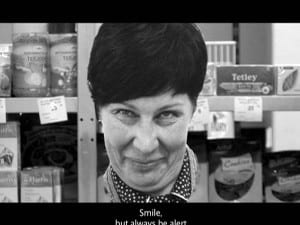Review by Joseph Ewens
Now in its 26th year, The Turner Prize has become an epicentre for contemporary art debate. Its mission to highlight the work of the country’s finest new creators places it firmly in the firing line for modern art’s detractors. Imagine the bubbling cauldron of fury unleashing itself onto internet message boards when it was announced that this year’s winner, Lowlands by Susan Phillipsz, doesn’t even feature anything you can see.
Thirty seconds in her room at the Tate Britain ought to convince you otherwise. The soundscape, crafted from three a capella renditions of a traditional Scottish folk tune, pushes the boundaries of auditory sensation. Her three recordings are meshed together to create a sound that is often asynchronous, but always whole. Philipsz was nominated for her installation under the bridges of Glasgow and versions of the piece can be heard at locations around the country.
Even with only an empty room to work with, her quavering performance has a profound effect. It feels as if the walls have come to life, singing a lament for all they’ve seen; reporting the sad history of their existence to the fleshy creatures who pass between them. Sometimes an almost inaudible call will come from one corner, with the rest of the room joining in chorus for the refrain. It’s a truly beautiful noise; of the kind only art could create.
To be fair to the Turner Prize’s wailing critics, some of fellow shortlister, Angela de la Cruz’s work could simply be detritus. Clutter I, for example, is indistinguishable from broken canvas and wood, dumped without thought into the middle of the floor. Thankfully, the rest of her deformed paintings are more effective, in particular Super Clutter XXL. The striking pink canvas is scrunched to one side, as if it has passed through some alternate dimension and come out the other side. Untitled is similarly space-warping. Attaching a matte black cuboid to an off-kilter, but otherwise pedestrian, filing cabinet, translates the metaphysical impact of all items onto the physical plane.
The exhibition opens with a room of paintings by Dexter Dalwood. His work is a mish-mash of objects, ideas, and references, each designed to represent a pivotal person or moment in Western culture. There’s a collage-like feel to a lot of his paintings, as if things relevant to the subject have been stuck haphazardly on top of each other. It creates a kind of perceptual dissonance, which can be distracting.
The simpler his work becomes, the better it is. Lennie, an evocation of the warm-hearted dullard from John Steinbeck’s Of Mice and Men, would be a comfortable portrait of idyllic American countryside, if it weren’t for a great rip in its centre. The gash, coloured in red and black, is a straightforward but effective metaphor for the way Lennie destroys George’s dreams with his own unwitting oafishness. Even simpler, and even better, is the stark Death of David Kelly. It is a very lonely painting that captures the isolation of a man becoming the epicentre of a media tornado.
The fourth and final shortlisted artists are known collectively as The Otolith Group. The first of their two video installations is a re-cut of Chris Marker’s French documentary about Greece. It’s an intellectual work that probably deals with some exciting and interesting issues, but a gallery isn’t really the place to watch a 13-part TV series.
What you should spend your time doing is sitting at the other end of the room, gazing at the 49 minute film, Otolith III. It takes inspiration from Satyajit Ray’s un-filmed screenplay, The Alien, presenting a tale from the perspective of the script’s fictional characters, who blame the director for not bringing them to life.
Things get a little more convoluted when one of the characters appears to be creating a film-within-a-film. The images on screen are culled from Indian films, combined with documentary clips of Ray and 1960s London, picked to match-up roughly with the voice-overs from the various characters. It’s a wonderfully mind bending idea that’s a pleasure to unravel, before you start considering what it has to say about the way created people cultivate an existence beyond the page.
The Turner Prize is likely to remain as controversial as ever, regardless of the work it champions. It’s best to ignore the hubbub and enjoy the exhibition for what it is – a snapshot of quality contemporary art that, while not truly exciting, repays engagement with insight, invention, and pure aesthetic pleasure.
Image: Susan Philipsz
Lowlands 2008/2010
Susan Philipsz at Turner Prize 2010
© Courtesy the artist, Tanya Bonakdar Gallery, New York and Isabella Bortolozzi Galerie, Berlin. Photo: Sam Drake and Lucy Dawkins, Tate Photography
3-channel sound installation, duration 8 minutes 30 seconds





